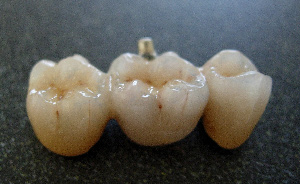All you need to now about Dental Bridges
Our website features the best health care professionals specialized in the field of dental bridges in Germany. All the doctors, cooperating with our company are competent specialists, who meet the strictest criteria of German dentistry. The dental treatment at German clinics is worth investing money.
Dental bridge is considered to be one of the most popular types of dentures used for restoration of a large quantity of missing teeth in Germany. They consist of some dental crowns connected with each other. Thus, load is distributed between the denture foundations, but a false tooth replacing the missing one is a few millimeters above the gum – leaving little space necessary for hygienic procedures.
Bridges for teeth/dental bridges
A fixed dental bridge is a construction that consists of a series of tightly joint dental crowns. It may only be used for restoration of two and more teeth placed one after another.
Typically, fixed and cantilever bridges need processing of the teeth next to a missing one. After all, the installation of the crowns on the processed teeth and their fixation to a false tooth, called intermediate take place.
In order to replace the missing teeth dental bridges (or dentures), dental implants and partial dentures are used. Fixed bridges – those that cannot be removed – are classified into conventional fixed, cantilever and adhesive dental bridges.
There are the following types of dental bridges in Germany
Dental bridges: Materials
- Porcelain fused metal bridges: optimal quality-price ratio, whereby today they are the most popular dentures all over the world, including Germany. They look very aesthetically, fixed firmly, but quite big and solid metal base requires a fairly strong live retainer turning.
- Bridges made of zirconium oxide or aluminum are the most serviceable of all the possible ones, and are generally recognized in Germany; oxides are incredibly aesthetic and robust materials that allow creating the most durable bridges – from 4 dental crowns and more. When choosing zirconium oxide, you can gain a very aesthetic smile (that looks almost indistinguishable from natural teeth), a firm fixation and extreme durability of your false teeth (over 20 years). A distinctive feature of oxides is firmness, which allows creating very thin constructions, so that the retainers need little turning.
Dental bridges: bridge work
- The dental bridge procedure is absolutely painless and safe
- Step 1: teeth and oral cavity are prepared to the denture fixation – dental plaque and bacteria are removed, bad teeth are treated, including the retainers (nerves are obligatory extracted from them), then they are turned and dental castings for further individual dentures are made.
- Stage 2: fixation – an individual denture made in a dental laboratory is fixed on the previously turned teeth and fixed by means of special, body safe, dental cement.
Bridges: The advantages
- The advantages of bridges are the following:
- lower cost
- durability: not less than 10 years with proper care
- the possibility to restore a large number of missing teeth in extremely short time
- easy care
CAD/CAM for bridges and crowns in Germany
The German clinics widely introduce the computer assisted technologies into their routine. CAD / CAM restorations tools provide the patients with crowns, bridges or implant accessories .CAD (Computer Aided Design) allows to manufacture bridges and crowns, tailored to your individual characteristics. The production of bridges and dental crowns is carried out with CAM technology (Computer Aided Manufacturing). The intelligent software programs and the innovative milling units provide the supreme quality of brifges and crowns .
Bridge installation costs depend on the type of material used. Prices for dental bridges in Germany vary from 400 up to 2500 euro.
Highly qualified dentists and medical staff, great experience and advanced technologies used in Germany allow us to avoid risks of complications with dental crowns almost entirely. If you appreciate your health, do not hesitate to try medical treatment in Germany!



.jpg)






































































 Loading ...
Loading ...


